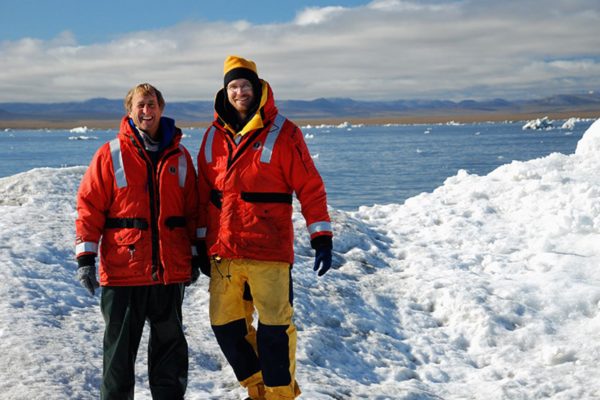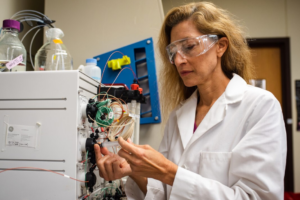AUSTIN, Texas — The National Science Foundation (NSF) has made a $5.6 million, five-year grant to The University of Texas at Austin to establish a Long Term Ecological Research (LTER) program and site along the northern Alaskan coast. Research at the site will focus on changes occurring both on land and in the ocean that affect Arctic ecosystems over time. This research could help native communities anticipate possible impacts of future climate changes on the fish and wildlife they depend on.
The grant establishes The Beaufort Sea Lagoons LTER (BLE-LTER), part of the largest, longest-lived network of ecological field sites in the United States. Once LTER programs are established, they are intended to operate indefinitely, with the NSF renewing funding in six-year increments. The project, the first marine-ecosystem LTER in the Arctic, is supported by the NSF’s Office of Polar Programs.
The coast along the Beaufort Sea is teeming with life. In scientific parlance, it has high biological productivity, meaning it generates biological matter at a high rate.
“The coastal zone of the Arctic is under-studied, yet we know from our previous work that the high biological productivity of these coastal lagoons is related to the seasonally dynamic exchanges that occur between the land and ocean,” said Kenneth Dunton, a professor at UT Austin’s Marine Science Institute (UTMSI) and principal investigator for the program. “Because the changes we see operate over such long time scales, the LTER program provides us with a unique opportunity to link physical events with ecological responses over seasonal to multidecadal periods.”
Scientists at UT Austin — in collaboration with researchers at the University of Alaska Fairbanks, Oregon State University, The University of Texas at El Paso, the University of Massachusetts at Amherst and the University of Toronto Mississauga — will lead the research.
BLE-LTER investigators will collaborate with members of local communities and with the U.S. Fish and Wildlife Service, which manages the Arctic National Wildlife Refuge. Long-term changes along the northern Alaska coast already are having, and are expected to continue to have, effects on the types of fish and other organisms that thrive in the lagoons.
“This project brings together fantastic scientific talent from across the nation, including experts in field ecology, water chemistry, physical oceanography, sea-ice processes, remote sensing, hydrological modeling and ecological modeling,” added James McClelland, co-leader of the project with Dunton and an associate professor at UTMSI. “Collectively this group has many decades of experience working on and thinking about how Arctic systems operate, but this new LTER provides a really exciting opportunity to work together toward integrated, interdisciplinary goals.”
The LTER research will help to create a framework for predicting the impacts of future changes on the coastal ecosystem, which could have important effects on native (Iñupiat) communities and their reliance on lagoon and coastal fisheries for their subsistence lifestyle. The lagoon food webs support large-scale coastal fisheries and more than 150 species of migratory birds and waterfowl.
“This LTER project includes the study of processes such as shoreline erosion, watershed runoff and sea ice dynamics that are central to coastal ecosystem function across the Arctic,” noted William Ambrose, director of the NSF’s Arctic Observing Network program. “An important aspect of this LTER is the collaboration between scientists and the Iñupiat residents of the Beaufort Sea coast, which will greatly deepen our comprehensive understanding of these ecosystems.”
The BLE-LTER will include seasonal field work during ice-covered, ice break-up and open-water periods, as well as deploying sensors to make continuous measurements of key biogeochemical and other aspects of the water system. Researchers will track how natural climate cycles influence coastal ecosystems in the Arctic and how the effects of Arctic climate-change — such as thawing permafrost, changes in precipitation and changes in sea ice coverage — alter those ecosystems.
“We are particularly excited to examine the processes that occur under the ice and during ice break-up, which we believe regulate food web pathways and diversity of species,” Dunton said.
The research team will also involve young citizen scientists from the communities of Utqiagvik (formerly Barrow) and Kaktovik, two of the nation’s three largest Iñupiat communities, in the research.
Along with Dunton and McClelland, the BLE-LTER includes co-principal investigators Amber Hardison, assistant professor of marine science at UT Austin; and Bailey McMeans, adjunct assistant professor from the University of Toronto Mississauga. The data management component of the project is led by Tim Whiteaker, a research scientist at UT Austin’s Center for Research in Water Resources.
The research will be based in Utqiagvik, Prudhoe Bay and Kaktovik, Alaska, and includes sites in Elson Lagoon, along the western Beaufort Sea; Simpson Lagoon and Stefansson Sound adjacent to the central Beaufort Sea; and Kaktovik and Jago lagoons, in the eastern Beaufort Sea.
The NSF supports a network of 25 existing LTER sites in ecosystems that include open ocean, coral reefs, deserts and grasslands. The University of Texas at Austin is one of only eight research institutions in the U.S. that manages a marine LTER.




